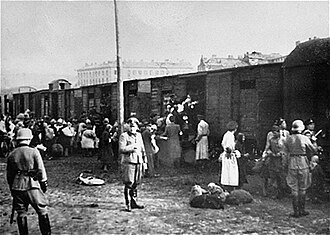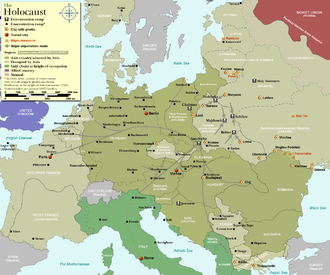
Back قطارات الهولوكوست Arabic Τρένα του Ολοκαυτώματος Greek Holocaust trains English Trenes del Holocausto Spanish قطارهای هولوکاست Persian Trains de la Shoah French טרנספורט HE Treni della morte Italian 홀로코스트 열차 Korean Ferrovias do Holocausto Portuguese
| Kereta api Holokaus | |
|---|---|
 Yahudi Polandia menaiki kereta api di Umschlagplatz, Ghetto Warsawa, 1942. Situs tersebut sekarang dijadikan monumen nasional Polandia. | |
| Operasi | |
| Periode | 1941 – 1944 |
| Lokasi | Jerman Nazi, Eropa yang diduduki Jerman, negar-anegara Blok Poros di Eropa |
| Para korban tahanan | |
| Tujuan | Ghetto transit, kamp konsentrasi Nazi, kamp buruh paksa dan kamp eksterminasi |

Kereta api Holokaus adalah transportasi kereta api yang dijalankan oleh sistem perkeretaapian nasional Deutsche Reichsbahn di bawah kontrol Jerman Nazi dan sekutu-sekutunya, dengan tujuan deportasi paksa Yahudi serta korban Holokaus lain, menuju kam konsentrasi Nazi, kamp buruh paksa dan kamp eksterminasi.[1][2] Eksterminasi orang-orang yang ditargetkan dalam "Solusi Akhir" tergantung pada dua faktor: kapasitas kamp-kamp kematian untuk menggas para korban dan pembuangan cepat terhadap jasad-jasad mereka, serta kapasitas kereta api untuk mengangkut korban-korban dari ghetto-ghetto Nazi menuju kamp-kamp eksterminasi.
- ^ Prof. Ronald J. Berger, University of Wisconsin–Whitewater (2002). Fathoming the Holocaust: A Social Problems Approach. Transaction Publishers. hlm. 57–58. ISBN 978-0202366111.
Bureaucrats in the Reichsbahn performed important functions that facilitated the movement of trains. They constructed and published timetables, collected fares, and allocated cars and locomotives. In sending Jews to their death, they did not deviate much from the routine procedures they used to process ordinary train traffic.
- ^ Simone Gigliotti, Victoria University, Australia (2009). The Train Journey: Transit, Captivity, and Witnessing in the Holocaust. Berghahn Books. hlm. 36, 55. ISBN 978-1845459277.